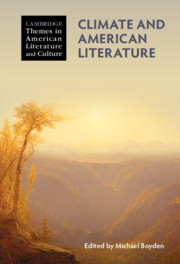Book contents
- Climate and American Literature
- Cambridge Themes in American Literature and Culture
- Climate and American Literature
- Copyright page
- Contents
- Figures
- Contributors
- Acknowledgments
- Introduction
- Part I Climate and Its Discontents
- Part II American Literary Climates
- Chapter 5 Climate and American Indian Literature
- Chapter 6 Colonial Climates
- Chapter 7 The Degeneration Thesis
- Chapter 8 The State of the Air in Post-Revolutionary America
- Chapter 9 The Higher Latitudes of the American Renaissance
- Chapter 10 Climate and the American West
- Chapter 11 Fictions of Health after Miasma
- Chapter 12 Naturalism, Regionalism, and Climate (In)determinism
- Chapter 13 American Modernisms and Climatology
- Chapter 14 Postmodern Climates
- Chapter 15 Frontiers of a Shrinking World
- Part III New Lines of Inquiry
- Bibliography
- Index
Chapter 9 - The Higher Latitudes of the American Renaissance
from Part II - American Literary Climates
Published online by Cambridge University Press: 18 February 2021
- Climate and American Literature
- Cambridge Themes in American Literature and Culture
- Climate and American Literature
- Copyright page
- Contents
- Figures
- Contributors
- Acknowledgments
- Introduction
- Part I Climate and Its Discontents
- Part II American Literary Climates
- Chapter 5 Climate and American Indian Literature
- Chapter 6 Colonial Climates
- Chapter 7 The Degeneration Thesis
- Chapter 8 The State of the Air in Post-Revolutionary America
- Chapter 9 The Higher Latitudes of the American Renaissance
- Chapter 10 Climate and the American West
- Chapter 11 Fictions of Health after Miasma
- Chapter 12 Naturalism, Regionalism, and Climate (In)determinism
- Chapter 13 American Modernisms and Climatology
- Chapter 14 Postmodern Climates
- Chapter 15 Frontiers of a Shrinking World
- Part III New Lines of Inquiry
- Bibliography
- Index
Summary
The US West has long evoked fantasies of climatological stability: the aridity of the Southwest; the soggy Pacific Northwest’s endless rain; the “humid fallacy” that Mike Davis has argued inaccurately overlaid a Mediterranean climate onto Southern California. Davis' derivation from a uniformitarian geological model is less apposite for the earthquake-prone landscape of Southern California than the dramatic alternations of a catastrophist sensibility. Davis thus points not simply toward a more accurate description of the material conditions of the US West, but to the narrative rhythm of its climate, which unfolds across long stretches whose consistency challenges narrative interest until punctuated by the sudden violence of a shift in weather. Alongside two other central figurations of the US West – the Garden of the World and the Great American Desert – this chapter tracks this rhythm through western American literary history.
Keywords
- Type
- Chapter
- Information
- Climate and American Literature , pp. 159 - 175Publisher: Cambridge University PressPrint publication year: 2021

